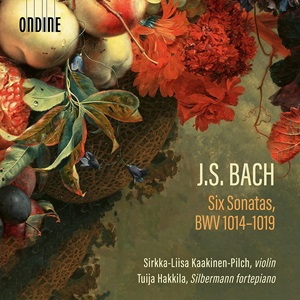
Johann Sebastian Bach (1685-1750)
Sonata for Violin and Keyboard No 1 in B minor, BWV 1014
Sonata for Violin and Keyboard No 2 in A major, BWV 1015
Sonata for Violin and Keyboard No 3 in E major, BWV 1016
Sonata for Violin and Keyboard No 4 in C minor, BWV 1017
Sonata for Violin and Keyboard No 5 in F minor, BWV 1018
Sonata for Violin and Keyboard No 6 in G major, BWV 1019
Sirkka-Liisa Kaakinen-Pilch (violin)
Tuija Hakkila (fortepiano)
rec. 2022, Karjaa Church, Karis, Finland
Ondine ODE1446-2D [2 CDs: 94]
J.S. Bach’s Six Sonatas, BWV 1014-1019, are some of his most delightful and popular chamber works, borne out by the substantial number of recordings of them. They weren’t published in the composer’s lifetime, and the date of their composition isn’t precise. Bach’s biographer Julian Shuckburgh suggests that they were written prior to 1725 when he was Kapellmeister to Prince Leopold at Cöthen. What is certain is that they underwent two revisions, the second about 1740. The likelihood is that they were composed in Cöthen and revised in Leipzig. In anticipation of the later classic duo sonata, the violin and keyboard are equal partners. C.P.E. Bach declared them to be “among the best works of my dear father.”
The sonatas are a great favourite of mine, both easy to enjoy and guaranteed to lift the spirits. Brimming over with attractive melody, the slow movements are soulful and expressive, whilst the fast movements are sprightly and stimulating. Kaakinen-Pilch and Tuija Hakkila combine beauty, intelligence and expressivity in their playing, with remarkable attention to detail. This is especially the case in the complex fugal writing of these rich tapestries, which never sounds congested, but is opened out to reveal its glories. The slow movements are probing; take, for instance, the Adagio of the F minor Sonatas, which is imbued with deep pathos. The faster movements convey a dancing playfulness. The finale of No 6 highlights the composer’s wit and quirkiness.
In my collection, I have recordings of these works with the keyboard role assigned to the modern concert grand, but mainly the harpsichord. I have to admit that this is the first time I’ve encountered them with a fortepiano. I’m not usually a great fan of them, but the instrument used in this recording I like very much. With a lighter sound than the modern piano, the action favours a more soft-spoken, crisp and characterful sound. At times, it sounds like a harpsichord. It seems ideal for an intimate domestic environment.
Sirkka-Liisa Kaakinen-Pilch performs on a beautiful rich-toned Giovanni Battista Rogeri violin (Brescia 1691), whilst the fortepiano employed by Tuija Hakkila is a copy of a Gottfried Silberman (1749) by Andrea Restelli, a contemporary builder. The Karjaa Church provides an ideal space, conferring warmth and intimacy to the recording. There’s an agreeable balance between the two instruments. David Yearsley’s liner notes provide excellent background to the music featured, in addition there are profiles of the artists.
Stephen Greenbank
Help us financially by purchasing from




















